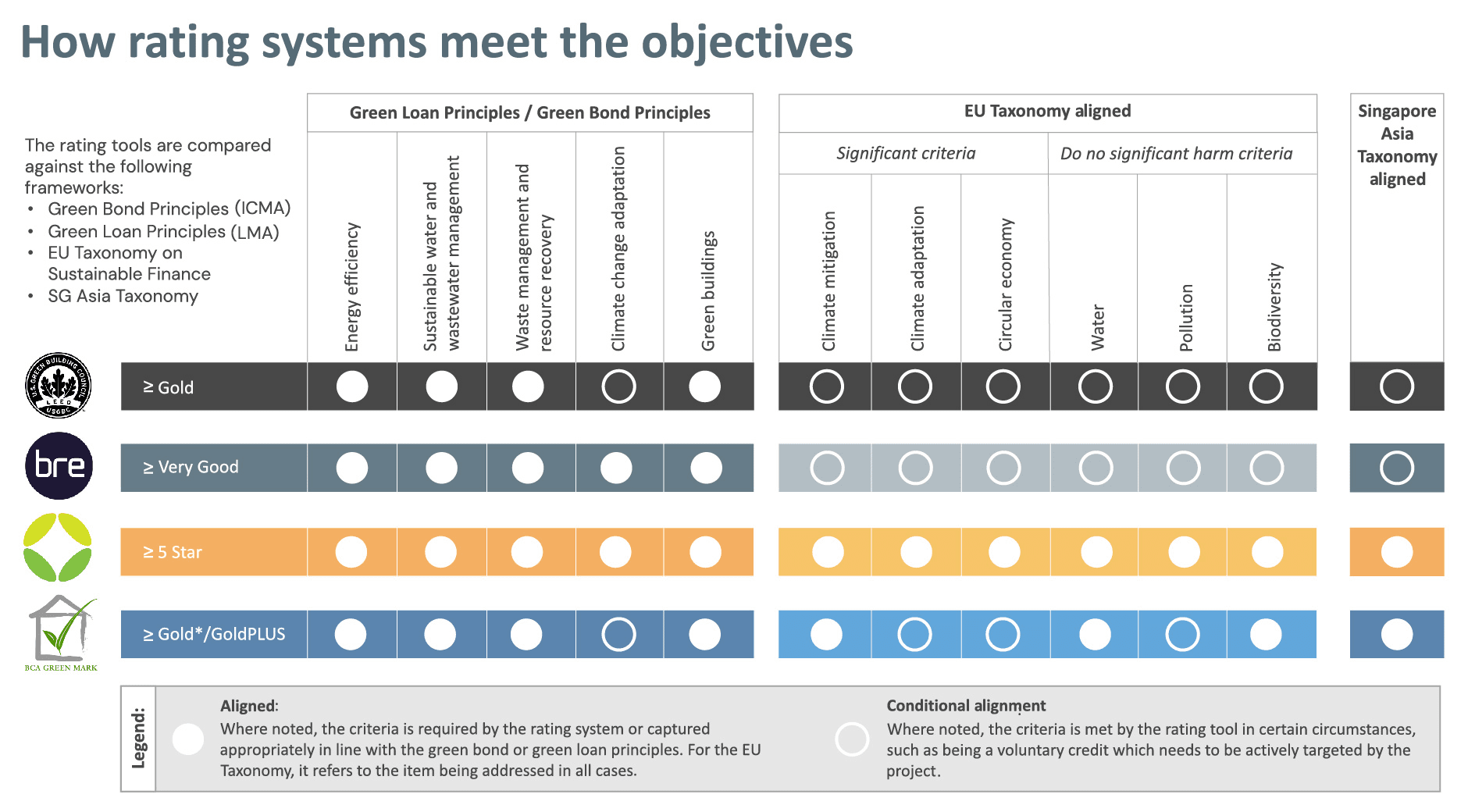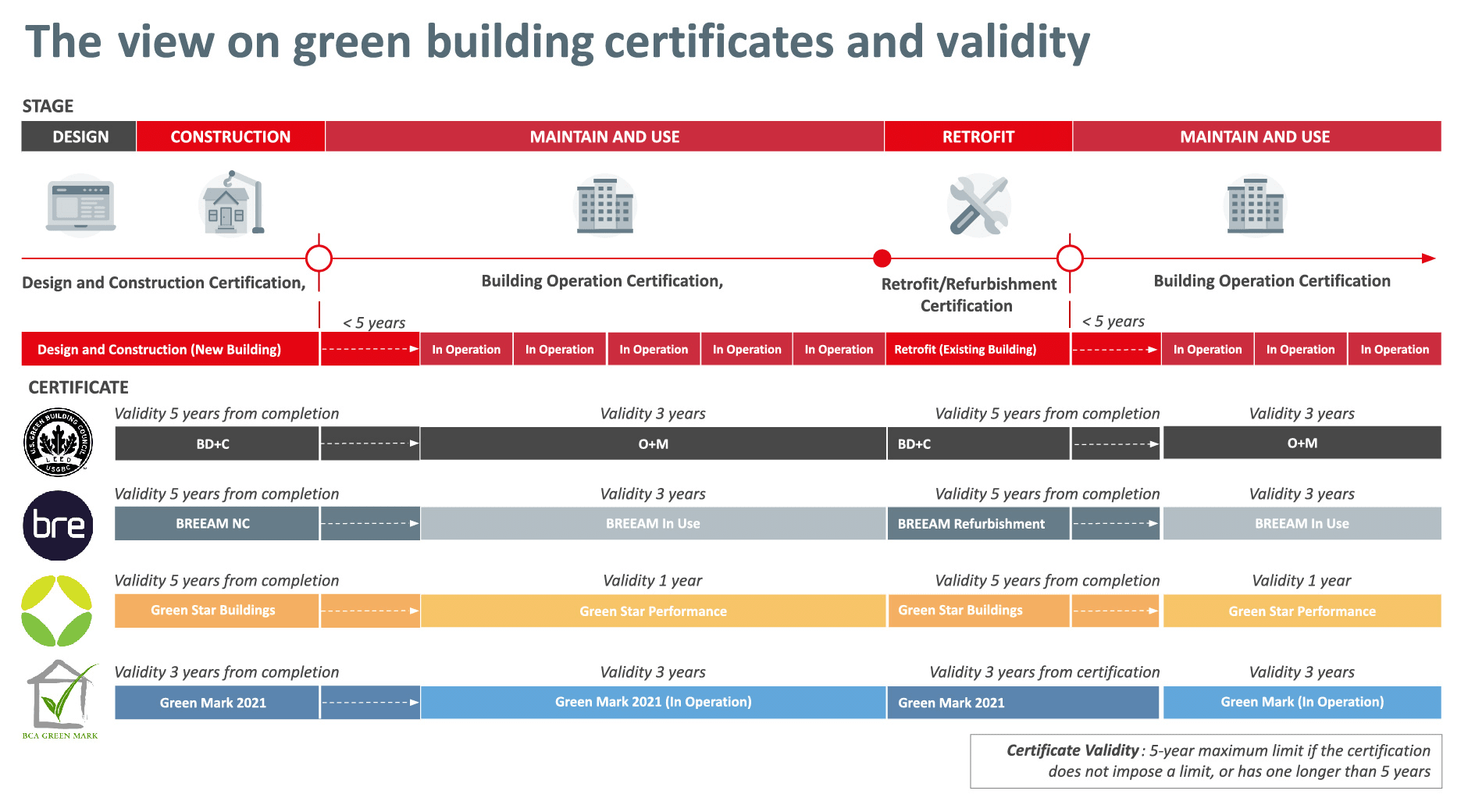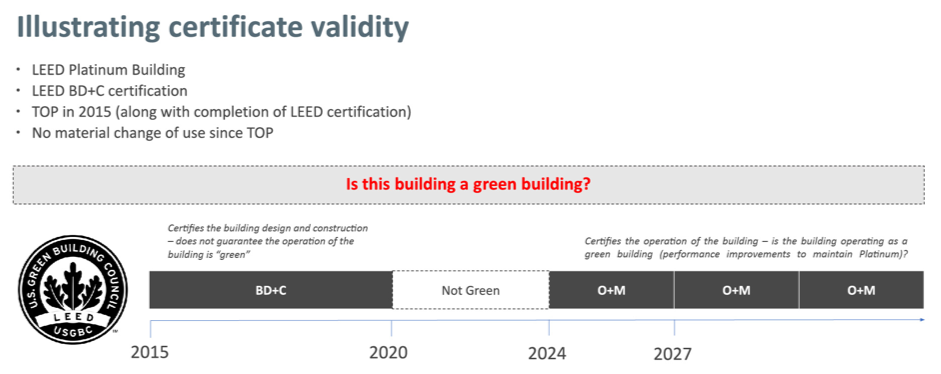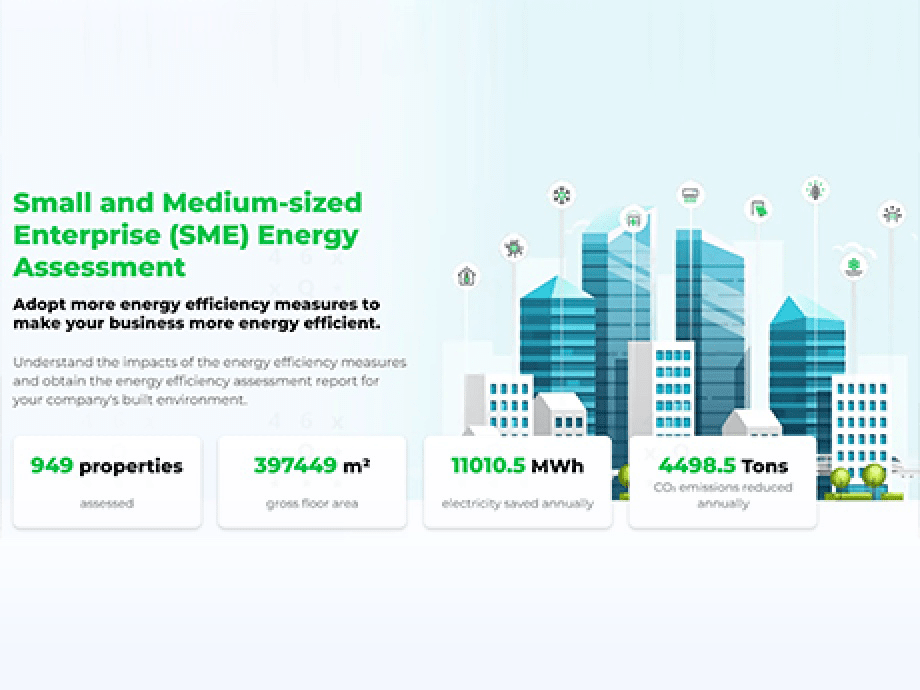Recognised as the Best Sustainability Linked Loan for Real Estate in Singapore by the Asset, OCBC’s first 1.5°C net-zero aligned loan with City Developments Limited (CDL) is aligned with CDL’s commitment to its Science Based Targets initiative (SBTi)- validated targets to achieve operational net zero by 2050.
The role of green buildings in sustainable finance
The role of green buildings in sustainable finance
This article summarises the key points in the recently launched ‘Financing Transformation: A Guide to Green Building for Green Bonds and Green Loans’ for which OCBC played a leading role in co-authoring through the Singapore Green Building Council. It also highlights some of the common gaps in understanding the use of green building rating tools, and how these can be bridged to unlock sustainable financing for the sector at an even larger scale.
Sustainable finance instruments are essential for driving the shift towards a low-carbon economy by directing capital to and supporting companies’ transition. In our core markets, OCBC actively works with our clients, developing and executing innovative sustainable financing activities within the built environment facilitated by established and robust green building standards.
Our green real estate portfolio accounts for a significant proportion of our total sustainable finance portfolio to date, which has grown to over S$60 billion in the first quarter of 2024. We have been privileged to share this approach with the wider built environment and financing community to further catalyse the strong connections between green buildings, rating tools and sustainable finance to unlock the net-zero transition at scale for the built environment.
Unlocking sustainable finance using green building ratings
Green building rating tools provide a framework on which a building’s sustainability performance is defined, assessed and verified at all stages of the building’s life. They contextualise strategic imperatives, such as climate action, resource efficiency, health and wellbeing, resilience, biodiversity and social impacts, and accord ratings based on how well these areas are addressed by the asset.
Buildings that have been certified by robust green building rating tools, such as BREEAM (Building Research Establishment Environmental Assessment Method), LEED (Leadership in Energy and Environmental Design), Green Star and Singapore’s Building and Construction Authority (BCA) Green Mark, provide a clear and credible signal of the sustainability credentials of the building. This makes them more attractive to a growing pool of green investors and financiers.
Why green building rating tools?
Rated (or certified) green buildings demonstrate a higher degree of certainty that they are performing as intended, and at higher efficiency than those without certification. What is measured is managed, and what is scrutinised is solved. Recent studies1 show that continuous independent verification through green building ratings yields results with demonstrable performance that is equal or better than the intended targets2. What is more, investors are increasingly looking at moving their investments to properties with credible certification as an assurance of high environmental performance.
OCBC’s analysis of our real estate financed emissions corroborates that green certified buildings (with valid certificates) outperform in emissions intensity compared to our financed buildings without valid certification. Green certified buildings are critical in our ability to meet our Net Zero targets, and thus we will continue to increase the share of our portfolio towards assets with valid green building ratings, and partnering clients on certification as a key and immediate transition strategy.
However, through our engagement with customers and other financial institutions across markets, we have found there are gaps in the understanding of green building rating tools, and their alignment with standards, frameworks and sustainable finance taxonomies. There is also a gap in the understanding of the evolving market expectations on what ratings can be defined as green or if ratings are evergreen where they have no explicit validity period of certification.
How to use green building ratings to harness sustainable funding opportunities?
Credible sustainable financing is guided by the Green Loan Principles3 and Green Bond Principles4 (the “Principles”), which provide a recommended framework of market standards and guidelines for use across the green loan and green bond market respectively. This includes the governance around the use of proceeds, the process for project evaluation and selection, the management of the proceeds, as well as transparency and reporting, including the environmental (and/or social) impact of the projects.
A key component of the Principles is that the use of proceeds must be directed toward eligible green activities. The Principles offer guidance on the broad of use proceeds categories eligible for green loans and bonds, such as energy efficiency and sustainable water management. These environmental factors are also often addressed in green building ratings, making ratings a valuable tool to demonstrate alignment to the Principles (see Figure 1).
Green building ratings can also help demonstrate alignment with the objectives of international taxonomies such as the Climate Bonds Taxonomy, and national and regional sustainable finance taxonomies such as the EU Taxonomy and Singapore-Asia Taxonomy. Sustainable finance taxonomies define the performance level of activities that are considered green and/or transition, providing market consistency on the eligible use of proceeds for green or transition loans and bonds.
Taxonomies vary greatly in their acceptance of rating tools. For example, the Singapore Asia Taxonomy explicitly lists the rating tools and rating levels that can be considered as “Green”, whereas the EU Taxonomy provides the screening criteria from which each project would need to align to. In the paper ‘Financing Transformation: A Guide to Green Building for Green Bonds and Green Loans’, rating tools were mapped to the EU Taxonomy (see Figure 1).

Figure 1: Leading green building rating tools do cover the key sustainability issues identified by the Principles and Taxonomies, in full by rating level, or in part by requiring the project to meet certain optional credits.
Source: Adapted from ‘Financing Transformation: A Guide to Green Building for Green Bonds and Green Loans’ with the addition of the Singapore Asia Taxonomy alignment by OCBC
Unlocking finance for brown asset upgrades using rating tools
Additionally, green building rating tools can be used to help demonstrate alignment with performance improvement thresholds in taxonomies, which is a critical way to unlock much needed capital to upgrade the wider stock of poorer performing properties and transitioning them at scale.
For example, in Australia, facilitating a NABERS (National Australian Built Environment Ratings System) 2.5-star building to achieve NABERS 4-star performance demonstrates a significant improvement of energy efficiency and emissions reduction. Whilst NABERS 4-star is not recognised as being “green” itself in most taxonomies, the level of improvement is aligned with the buildings upgrade criteria for EU Taxonomy, the Climate Bonds Taxonomy (>30% reduction in emissions), as well as the transition (amber) category of the Singapore-Asia Taxonomy.
The same approach can be translated to other rating tools such as Malaysia’s Green Building Index (GBI), where an asset attaining >30% improvement in its Building Energy Index (BEI) target may be eligible for a transition loan under the Singapore-Asia Taxonomy, even if the certification level of GBI rating cannot be achieved for a building in operation or undergoing refurbishment.
Enabling clear impact reporting with rating tools
Impact reporting is a key pillar of the Principles, to enhance the integrity and transparency of sustainable finance allowing investors and financiers to allocate capital drives impact. Green building rating tools capture and present the relevant information required, helping to communicate the environmental impact of the project or activity clearly.
Challenges for rating tools, and an opportunity for greater alignment
Key challenges from our experience are as follows:
- Market alignment and understanding on green building certification use and validity
- Clear differentiated building performance metrics (energy efficiency and emissions intensity)
Alignment and understanding of validity of certification
Education is critical and we have been championing the importance of regular certification with our clients and peers, as it ensures that a building continues to deliver on its “green” credentials. But what defines a valid certificate?
Aligned with the Singapore-Asia Taxonomy, OCBC takes the view that a green building certificate must be “valid” for a building to be considered as “green”. This means that the rating must be appropriate to the building life stage and current to be reflective of the building performance. As such, a certificate that has no expiration date, such as LEED Building Design and Construction (BD+C), Green Star Buildings or BREEAM New Construction (NC), would only be seen as valid for 5 years post practical completion of the project. After this, the corresponding "in-operation" certificate would be needed for the building to continue to be considered as a green building, such as LEED Operations and Maintenance (O+M).
Recognition of green building certificates over the lifecycle of the building

Figure 2: Rating tools should be used and maintained over the lifecycle of the building, to give assurance that the building is designed, constructed, operated and retrofitted as a green building.
In short, a valid green building certificate is one that is:
- From a Robust Green Building Rating Tool5 which defines performance that is significantly better than business as usual.
- Relevant for the building’s stage of life, for example design and construction, in operation (maintenance and in-use stage) and retrofit and refurbishment.
- Be up to date and reflective of current performance, meaning having a limit of 5 years if the certificate has no expiry date or one longer than 5 years.

Figure 3: Illustration of green building certification validity
Take the example of a building that has obtained a LEED Building Design and Construction (BD+C) Platinum certification. The building obtained a Temporary Occupation Permit (TOP) in 2015, along with completion of LEED certification. There has been no material change of use of the building since TOP. Is this building a green building, in 2024?
In this example, the answer is no. For the building to be considered “green”, it would need to have a valid LEED O+M (Operations and Maintenance) certificate at Gold or higher, as the initial certification is outside of a “valid” period.
Building performance metrics are key for investors, financers and tenants
Investors financers and corporate tenants are keenly looking at their portfolios and their alignment to taxonomies and decarbonisation pathways (such as CRREM). This means some are looking beyond established Green Building Certifications, where there is a lack of differentiated building performance metrics. Rating tools such as Green Mark and Green Star meet the market needs being well structured around explicit energy performance requirements for each rating level. There are, however, gaps for leading rating tools including BREEAM and LEED (including the drafts for LEED V5 and BREEAM V7) when it comes to differentiated energy or emissions performance requirements at for different ratings, which is at tension with the wants and needs of the market. Whilst in the interim this can be bridged through bespoke taxonomy mapping tools, and specifying key credits being achieved in addition to the ratings. However in order for these tools to maintain their relevance in the longer term, they will need to evolve.
An opportunity:
There is a great opportunity for green building rating tools and the finance community to work closely together to bridge the current gaps. This would give the market the consistency and transparency needed to further scale action and adoption of rating tools to unlock the necessary capital to drive the transformation of the sector.
OCBC stands ready as your trusted partner
All buildings must dramatically become more energy efficient and hasten the shift to being all-electric removing onsite combustion of fossil fuels. This should be accompanied by efforts to improve water conservation, reduce waste streams and eliminate use of harmful refrigerants.
All of this requires capital. At OCBC, we have been actively partnering our clients to design, develop, retrofit and acquire green buildings.
Our award-winning solutions to support your transition
Whether you are just getting started on your sustainability journey or have already taken ambitious steps to decarbonise your portfolio, we have a suite of innovative solutions catered to your needs.

The OCBC 1.5°C Loan

Green Loan with Carbon Credits
The market-first solution with Frasers Centrepoint Trust (FCT) combines a green loan for the Tampines 1 building, with carbon credits equivalent to the financed emissions associated with the green loan, sourced through OCBC’s Emissions Trading Desk.

The SME Energy Efficient Assessment (SMEEA)
A collaboration with Singapore’s BCA, the online self-assessment tool is free to use for our SMEs, fast and impactful, enabling SMEs easy access to green building certification and green finance.
Read more about our sustainable financing solutions for SMEs.
Developing your sustainable finance frameworks
We can help to develop your sustainable finance framework aligned with best practices and model language, facilitating your access to sustainable and transition finance instruments globally.
Our leading advisory to support your net-zero transition and certification journey
Navigating the path to Net Zero can be complex. With OCBC’s deep understanding of the built environment sector and technical expertise on sustainability, we are well placed to support you in your certification and decarbonisation journey.
We have advised clients on achieving Green Building Certification at an asset level, to working with clients on analysis of global portfolios of assets and their longer term 1.5°C alignment. With our leading transition advisory service, we are helping our clients understand the actions they can take to improve their sustainability performance, helping them set credible sustainability targets while bringing capital to these efforts through our sustainable financing solutions.
Reach out to your OCBC Relationship Manager to find out more.
Conclusion
As we move towards a net-zero future, the built environment stands at the forefront of this critical transformation. OCBC as a leading provider for sustainable financing solutions to the built environment is well placed to help you navigate the transition and provide financing solutions that supports your organisation.
For more information, read the ‘Financing Transformation: A Guide to Green Building for Green Bonds and Green Loans’.
Footnote
1Australia’s green buildings performing as promised | Green Building Council of Australia (gbca.org.au)
2Analysis by the National Australian Built Environment Rating System (NABERS) in Australia shows the impact of consistent measurement and ratings – over the 12-year period of mandatory office ratings, the Australian market for office buildings saw a 41% reduction in energy intensity NABERS Annual Report 2022-2023 Life of Program Statistics – Improvements in average energy intensity.
3The Green Loan Principles published by the Asia Pacific Loan Market Association, Loan Market Association, and Loan Syndications and Trading Association.
4The Green Bond Principles published by the International Capital Markets Association.
5Rating Tools that are recognised by federal or national governments, administered by a green building council that is a member of the World Green Building Council, or recognised a proxy by Climate Bonds initiative, and aligned with the screening criteria of internationally credible sustainable finance taxonomies are considered by OCBC as being “robust”.
Disclaimer
This publication is solely for information purposes only and may not be published, circulated, reproduced or distributed in whole or in part to any other person without our prior written consent. This publication should not be construed as an offer or solicitation for the subscription, purchase or sale of the securities/instruments mentioned herein. Any forecast on the economy, stock market, bond market and economic trends of the markets provided is not necessarily indicative of the future or likely performance of the securities/instruments. Whilst the information contained herein has been compiled from sources believed to be reliable and we have taken all reasonable care to ensure that the information contained in this publication is not untrue or misleading at the time of publication, we cannot guarantee and we make no representation as to its accuracy or completeness, and you should not act on it without first independently verifying its contents. The securities/instruments mentioned in this publication may not be suitable for investment by all investors. Any opinion or estimate contained in this report is subject to change without notice. We have not given any consideration to and we have not made any investigation of the investment objectives, financial situation or particular needs of the recipient or any class of persons, and accordingly, no warranty whatsoever is given and no liability whatsoever is accepted for any loss arising whether directly or indirectly as a result of the recipient or any class of persons acting on such information or opinion or estimate. This publication may cover a wide range of topics and is not intended to be a comprehensive study or to provide any recommendation or advice on personal investing or financial planning. Accordingly, they should not be relied on or treated as a substitute for specific advice concerning individual situations. Please seek advice from a financial adviser regarding the suitability of any investment product taking into account your specific investment objectives, financial situation or particular needs before you make a commitment to purchase the investment product. OCBC Bank, its related companies, their respective directors and/or employees (collectively “Related Persons”) may or might have in the future interests in the investment products or the issuers mentioned herein. Such interests include effecting transactions in such investment products, and providing broking, investment banking and other financial services to such issuers. OCBC Bank and its Related Persons may also be related to, and receive fees from, providers of such investment products. OCBC and/or its related and affiliated corporations may at any time make markets in the securities/instruments mentioned in this publication and together with their respective directors and officers, may have or take positions in the securities/instruments mentioned in this publication and may be engaged in purchasing or selling the same for themselves or their clients, and may also perform or seek to perform broking and other investment or securities-related services for the corporations whose securities are mentioned in this publication as well as other parties generally.
This report is intended for your sole use and information. By accepting this report, you agree that you shall not share, communicate, distribute, deliver a copy of or otherwise disclose in any way all or any part of this report or any information contained herein (such report, part thereof and information, “Relevant Materials”) to any person or entity (including, without limitation, any overseas office, affiliate, parent entity, subsidiary entity or related entity) (any such person or entity, a “Relevant Entity”) in breach of any law, rule, regulation, guidance or similar. In particular, you agree not to share, communicate, distribute, deliver or otherwise disclose any Relevant Materials to any Relevant Entity that is subject to the Markets in Financial Instruments Directive (2014/65/EU) (“MiFID”) and the EU’s Markets in Financial Instruments Regulation (600/2014) (“MiFIR”) (together referred to as “MiFID II”), or any part thereof, as implemented in any jurisdiction. No member of the OCBC Group shall be liable or responsible for the compliance by you or any Relevant Entity with any law, rule, regulation, guidance or similar (including, without limitation, MiFID II, as implemented in any jurisdiction).
Discover other articles about:
Important note
You will be directed to a third party website. OCBC Bank shall not be liable for any loss suffered or incurred by any party for accessing the third-party website or in relation to any product and/or service provided by any provider under the third-party website.
Important note
You will be directed to a third party website. OCBC Bank shall not be liable for any loss suffered or incurred by any party for accessing the third-party website or in relation to any product and/or service provided by any provider under the third-party website.
Important note
You will be directed to a third party website. OCBC Bank shall not be liable for any loss suffered or incurred by any party for accessing the third-party website or in relation to any product and/or service provided by any provider under the third-party website.
